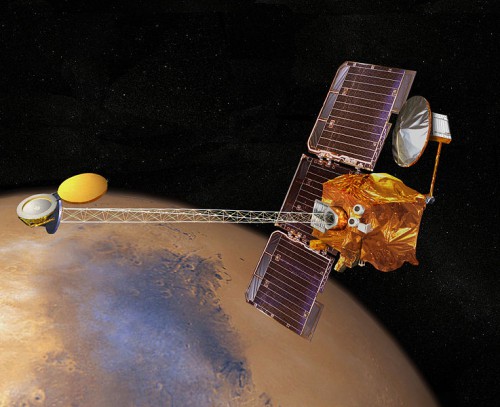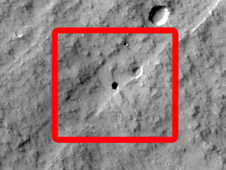
NASA’s Mars Student Imaging Project (MSIP)—part of the agency’s Science Mission Directorate education and outreach initiative—has won a new education prize from the journal Science. The project, which began in 2002, has seen the participation of more than 35,000 students of many ages and abilities from across America in an effort to foster awareness and interest in Mars and its mysteries.
The award also offers another feather in the cap for the Mars Odyssey spacecraft, which has circled the Red Planet for more than a decade, monitoring seasonal changes and functioning as a communications relay for NASA’s surface rovers. Under the provisions of MSIP, students ranging in age from fifth grade to college level are offered the opportunity to take a photograph of the planet’s surface using Mars Odyssey’s Thermal Emission Imaging System (THEMIS) visible and infrared instrument. They can then use this photograph to answer their own research questions. In June 2010, a seventh-grade MSIP class from Evergreen Middle School in Cottonwood, Calif., helped investigators to discover a hitherto-unknown series of lava tubes, including one with a pit crater, on Pavonis Mons. The students presented their results at a major planetary science conference.

In winning Science’s Prize for Inquiry-Based Instruction, more than a decade of work to make MSIP a reality has been recognized for its “outstanding, inquiry-based science and design-based engineering education.” A panel of scientists and teachers selected MSIP as one of a dozen education projects from fields as diverse as biology, chemistry, physics, and the Earth sciences. MSIP is run jointly by NASA and Arizona State University’s Mars Education Program. All of the selectees demonstrated their ability to fit within the national Science, Technology, Engineering, and Mathematics (STEM) framework.
“At a time when the U.S. critically needs to develop the next generation of scientists and engineers, such student-led discoveries speak to the power of engaging students in authentic research in their classrooms today,” said Jim Green, director of the Planetary Science Division of NASA’s Science Mission Directorate in Washington. “Not only is the chance to explore Mars motivating, it shows students they are fully capable of entering challenging and exciting STEM fields.”
Veteran astronaut and current NASA Associate Administrator for Education Leland Melvin added: “The Mars Student Imaging Project is a perfect example of how NASA can use its missions and programs to inspire the next generation of explorers. If we want our students to become tomorrow’s scientists and engineers, we need to give them opportunities to do real-world—or, in this case, out-of-this-world—scientific research, using all of the tools of 21st century learning.”




project—mars–one—-possible
i–support–project